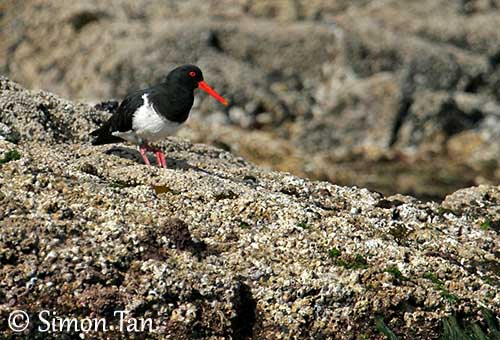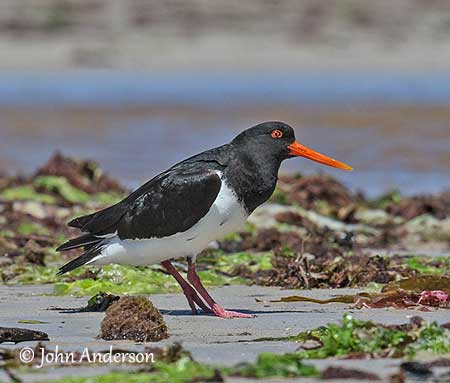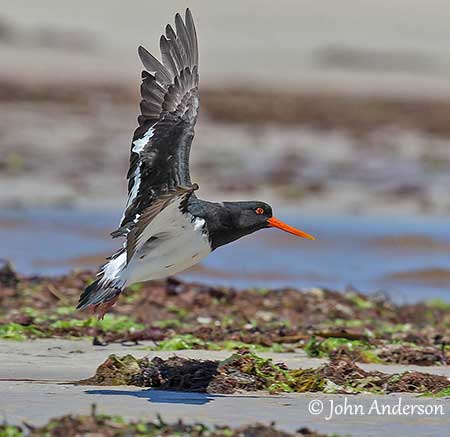
Fr: Huîtrier des Chatham
Ang: Chatham Oystercatcher
All: Chathamausternfischer
Esp: Ostrero de las Chatham
Ita: Beccaccia di mare dell'Isola di Chatham
Nd: Chathamscholekster
Sd: Chathamstrandskata
Photographers:
John Anderson
John Anderson Photo Galleries
Simon Tan
PBase Bird galleries
Text by Nicole Bouglouan
Sources:
HANDBOOK OF THE BIRDS OF THE WORLD Vol 3 by Josep del Hoyo-Andrew Elliott-Jordi Sargatal - Lynx Edicions - ISBN : 8487334202
SHOREBIRDS by Peter Hayman, John Marchant and Tony Prater – Christopher Helm – 1986 – ISBN: 0747014035
Avibase (Lepage Denis)
BirdLife International (BirdLife International)
New Zealand bird status between 2008 and 2012
Te Ara – The Encyclopedia of New Zealand
Notornis and Birds New Zealand
The recovering population of the Chatham Island Oystercatcher
Chatham Oystercatcher
Haematopus chathamensis
Charadriiformes Order - Haematopididae Family
INTRODUCTION:
The Chatham Oystercatcher has extremely small population but increasing, thanks to intensive conservation efforts. From as few as 50 individuals in 1970, to about 300 by 2006, the increase of these numbers is due to predator control, cattle exclusion and protection of nests from high tides in northern Chatham Islands.
The Chatham Oystercatcher has typical pied plumage, and is the only resident oystercatcher on these islands.
DESCRIPTION OF THE BIRDS:
Biometrics:
Length: 48 cm
Weight: M: 540 g – F: 640 g
The adult is a sturdy bird with black head, neck, upperparts and breast. The upperwing shows a white wingbar. The rump is white, but the tail is black.
The underparts are white, including the underwing-coverts. The leading and the trailing edges are black. The black lower breast is narrowly bordered by a spotted black-and-white band extending to shoulders.
The long bill is red with orange tip and base. The eyes are red, surrounded by red-orange eyering. Legs and feet are pink.
Both sexes are similar in plumage, but the female is slightly larger than male.
The juvenile has duller bare parts. The eyes are dull reddish-brown. The bill is mostly orange with black tip. Legs and feet are pinkish-white.

RANGE:
The Chatham Oystercatcher occurs on Chatham, Pitt, South East (Rangatira) and Mangere Islands, New Zealand.
HABITAT:
The Chatham Oystercatcher breeds on sheltered coastlines on rocky and sandy coasts. The nesting sites are usually close to the feeding areas available during the tidal cycles. It can feed in stream mouth or among kelp, and also on rocky platforms at low tide.
During winter, it can be seen sometimes foraging in farmland.
CALLS AND SONGS: SOUNDS BY XENO-CANTO
The Chatham Oystercatcher utters soft calls in flight, but on the ground, the adults give piercing screech and squawk calls.
During the displays, both courtship and territorial defence, it usually gives high-pitched piping calls.
BEHAVIOUR IN THE WILD:
The Chatham Oystercatcher feeds on invertebrates found in rocky and sandy substrates. It feeds on a variety of preys such as gastropods, bivalves, barnacles, isopods, echinoderms, worms, molluscs, crustaceans, ascidians and anemones.
Like other oystercatchers, it attacks the preys with different techniques such as hammering, prizing, probing and stabbing.
It forages on rocks and sandy beaches among kelp debris, and even in adjacent farmland, especially during winter. The feeding areas are defended all year round.

REPRODUCTION OF THIS SPECIES:
The breeding season occurs between October and March, with the laying from October to December.
The Chatham Oystercatcher nests on the ground. It makes a scrape on sand or gravel, above the waterline, or a lined depression on rocky outcrop, but also among the low vegetation.
The female lays 2-3 creamy-white eggs with blackish spots, making them almost invisible on the ground. Both adults share the incubation during 27-29 days. The chicks are precocial and leave the nest very soon after hatching. They hide among the tidal debris and their cryptic plumage with heavily spotted upperparts provides them good camouflage as they blend in with the environment. They fledge at six weeks of age. They may disperse between islands, or they remain in family groups during several months.
PROTECTION / THREATS / STATUS:
After the past conservation efforts in the early 1990s, the Department of Conservation began another management programme for the Chatham Oystercatcher in 1998, including predator control, relocation of nests away from the high tideline, dune restoration to provide more habitat and video monitoring for nests.
In 1999, a joint programme started and has been successful, involving the establishment of new breeding pairs, good numbers of produced chicks, banding of these chicks for future monitoring and research to follow the breeding success, nest losses and bird movements.
Thanks to these efforts, the Chatham Oystercatcher’s population has increased and appears fairly stable. It was estimated at 310-360 individuals in 2006, but the number of mature birds in breeding pairs remains below 250.
Currently, the Chatham Oystercatcher is listed as Endangered species, due to small population and restricted range.
The Chatham Oystercatcher is territorial during the breeding season and the territory is strongly defended, including outside this period.
They are monogamous with long-term pair-bonds. During the displays, the bright-coloured bare parts and the black-and-white plumage are enhanced by adapted postures accompanied by piping calls.
The Chatham Oystercatcher is sedentary, but the juveniles may disperse up to 40 kilometres between islands and may form small flocks. They can be seen outside the breeding areas on lagoon and pond shorelines.
The flight is powerful, fast and direct.

